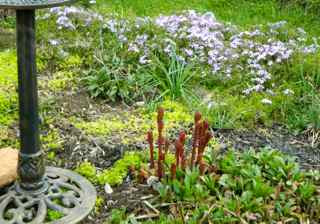 |
| Blooming lilac and crabapple in my garden today. |
As a gardener, three sources of inspiration for me are garden books, garden blogs, and visiting beautiful gardens.
1. BOOKS
Years before I gardened, when I needed an escape from the stress of my job, I read about gardening and began collecting garden books. My personal library continues to expand, but last week, for Earth Day, I read a book from the church library (where I am volunteer librarian) to our preschoolers there. I have chosen this children's book, The Oak Inside the Acorn by Max Lucado, as my entry for the Earth Day Reading Project sponsored by Michelle at The Sage Butterfly. I feel this is a fitting choice for a post on Inspiration, as Lucado is considered one of America's leading inspirational authors. The lovely illustrations are by George Angelini.
2. BLOGS
Donna of Garden Walk Garden Talk asked a similar question in her recent Earth Day posting. My place on Planet Earth has changed over the years. Today, I am many things, not least of which is a gardener.
I am also a garden blogger, finding inspiration from other bloggers. It was my good fortune to meet two of them recently: Carolyn of Carolyn's Shade Garden and Julie who blogs at Wife, Mother, Gardener. It was Julie's idea for Pennsylvania garden bloggers to get-together. It was a wonderful weekend.
 |
| From left to right: Carolyn, me, and Julie in Carolyn's garden. |
3. BEAUTIFUL GARDENS
Carolyn's beautiful garden is a true inspiration. One of my favorite spots there is the woodland garden where all sorts of hostas, ferns and native plants can be found. It is how I wish my Woodland Walk looked, but until we eradicate the invasive plants and build a deer fence, I'm afraid it will never happen.
 |
| Carolyn's woodland garden. |
 |
| Arisaema triphyllum Jack-in-the-Pulpit |
 |
| Aquilega Canadensis Wild Columbine |
I placed the planter next to the swing in my shade garden, where I can admire them when I sit there.
With Julie and Carolyn, HH and I visited Chanticleer, a forty acre garden near Philadelphia. Carolyn gave us a tour ...
 |
| Chanticleer is the name given to a rooster, especially in fairy tales. |
 |
| One of the romantic winding paths at Chanicleer. |
 |
| Part of an unusual seating group at Chanticleer |
I loved the plant groupings at Chanticleer. Obviously a great deal of thought is given to the pairings.
 |
| Yellow tulip with yellow-edged hosta. |
 |
| The fountain garden at Longwood |
 |
| The conservatory |
 |
| Delphinium 'Astolat' Pacific Giant Group |
 |
| Delphinium 'Astolat' Pacific Giant Group |
Of course, I have lots more photos of my visits to these inspirational gardens. Expect more in future postings. And thank you Julie and Carolyn! You prove what I have always thought, Garden Bloggers are the Best!!
Finally, I get inspiration when taking my morning walk around my own garden. Today, not only are the crabapple tree and lilacs blooming, but also my weeping redbud. Unfortunately, my camera didn't pick up the true lavender color of the blossoms.
 |
| Weeping Redbud 'Lavender Twist' |
In this posting I am not only linking with Sage Butterfly's Earth Day Reading Project meme, but also Donna's Word4Wednesday at Garden Walk Garden Talk. I haven't forgotten Holley at Roses and Other Gardening Joys whose meme 'Monthly Garden Book Review' I missed this month, but I do encourage you to go over there and get some great reading inspiration. Also, do visit Carolyn's Shade Garden, both the blog and the place if possible; and you will love Julie's Wife, Mother, Gardener blog which is sure to inspire you.
Happy reading, happy blogging, and happy gardening!
Pamela x
 |
| With HH at Chanticleer (photo by Julie) |
~~ I love reading your comments. I hope you leave one so I’ll know you visited!
I look forward to visiting your blog in return.











































